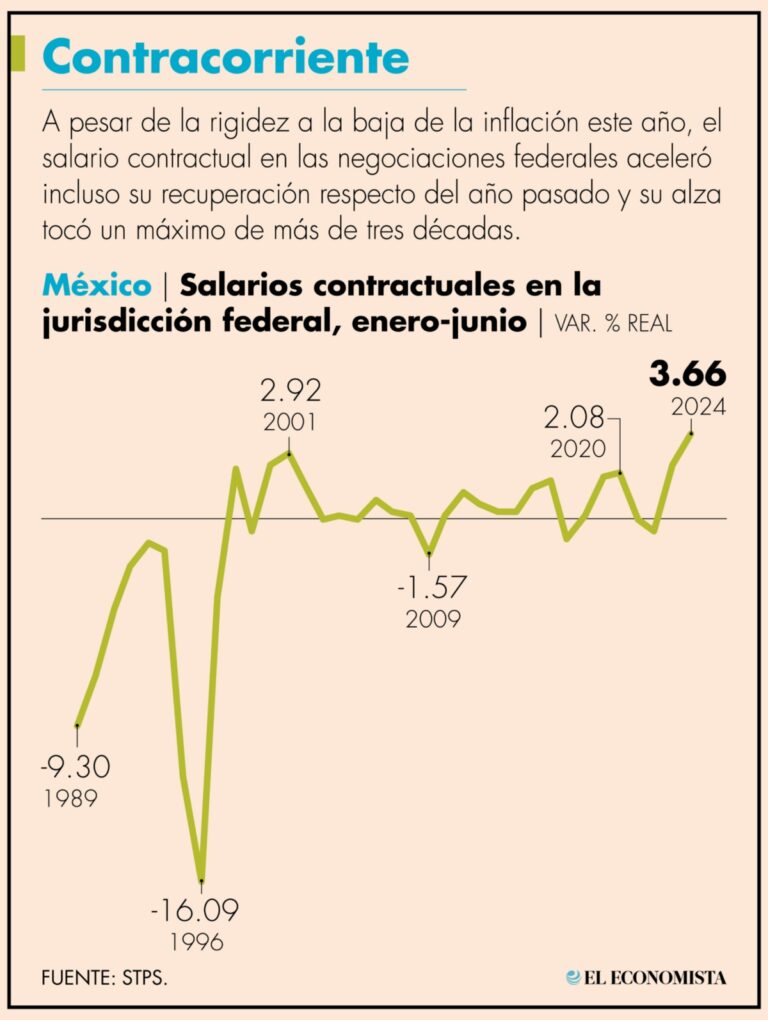Salary reviews in the federal jurisdiction had an actual growth of 2.0% in 2023 and, thus, they reached their best level since 2001 (2.3%), according to data from the Department of Labor and Social Welfare (STPS). In all months, contractual remunerations maintained increases in real terms; that is, the balance between the nominal adjustment and the effect of inflation.
Last year the average nominal increase was of 7.6%, the best negotiations were seen in January (10.2%), April (10.0%) and November (11.6%), the latest one being the highest nominal increase since November of 2000.
“We find the most aggressive compensation at the level of the Bajío Region and in the North. Here we confirm the law of supply and demand, the tabulators of unionized personnel have had to accelerate due to the increase of the minimum wage, significant union pressure for the legitimation of collective bargaining agreements and a trend in the market of negotiating contracts upward, particularly in the areas with high demand”, Rocío Hernández, director of Consulting and Compensation at AON México, explained.
Before the positive report for 2023, remunerations for unionized workers had shown a decrease in real terms for two consecutive years due to the inflationary context. The balance for 2021 was of -0.5% and 2022 ended with an actual decrease of -1.8%, the worst figure since 1996.
For Carlos Ramírez, director of Development at Integralia Consultores, the actual growth of salaries is explained by a combination between a decrease in inflation and nominal increases, which remained high.
“If we break it down by sector, we see higher increases. If we look at data from the maquila sector, we see increases above 5% in real terms. The winds are in favor in salary matters; additionally, the increase to the minimum wage has had a mirror effect on the rest of the salary negotiations. A second factor that has an effect is the shortage of workers that is found in some of the country’s regions”, the specialist explained.
During 2023, 2,957 salary reviews were conducted in the federal jurisdiction, with the participation of a little over 2 million unionized workers; this involves a group of 227,638 additional workers in comparison to those who benefited in 2022 from the increase in contractual remuneration.
According with an analysis by D&M Abogados, salary negotiations in the first quarter of 2023 were almost three points above the level of inflation. For Blanya Correal, director of the Division of Labor Engineering of the Firm, the recovery of contractual salaries could have been linked with the final deadlines for legitimating collective bargaining agreements.
Another factor could have been the pressure of independent unions. “Some confederated unions assumed capacity as if they were in the possession of an independent union.”
And even though achieving salary increases above inflation is a positive thing for the workers, the specialist considered that this is a phenomenon that must be cause for reflection. “The cause for concern for me is, how sustainable is this process? Because if the first year they ask me for a diamond ring, the second year for a diamond necklace, by the third year I don’t know what diamond thing they are going to ask from me in order to maintain acceptance by the workers.”
In this sense, Carlos Ramírez was of the opinion that, despite the good forecast for salary increases in 2024 as a consequence of a low unemployment rate and a new increase to the minimum wage, this performance in salary revisions will not be sustainable if productivity does not increase.
“Companies have been able to adapt to higher salary increases but, clearly, these have been increases almost by decree, the guiding axis of these pressures on salaries, to a large extent, has been the decision by the federal government of increasing the minimum wage, but without considering the factors that drive sustainable increases over time, such as productivity”, the specialist said.
In a regional report, the Economic Commission for Latin America and the Caribbean (ECLAC) and the International Labor Organization (ILO) point out that the deceleration of inflation in 2023 had an effect on the actual increase of the average minimum wages, although only four countries showed an improvement in this area (Brazil, Mexico, Peru, and Uruguay).
“Despite the decrease in inflation, average minimum wages show different evolutions. Of the 11 countries that were considered with available information, seven show a contraction and four show an increase of the actual average minimum wage in the first semester of 2023”, the international bodies highlight in their report Employment Situation in Latin America and the Caribbean.
Perspectives of salary increases in 2024
The last Compensation Survey by AON foresees an average salary increase of 8.8% for unionized personnel in 2024. Half of all negotiations will be conducted during the first few months of the year.
“As months go by, data (on increases) goes upward. We are talking of increases of close to 9 percent in 2024 . There are organizations that are in fact working with 5% or less, but we are already seeing double digits and they are changing for unionized workers; before, talking about double digits was equivalent to 10%, today we hear 20% in some cases. Additionally, the legitimations of collective bargaining agreements have given surprises”, Martha Hernández, director of Consulting in Human Capital at AON México, pointed out.
The regions of the Bajío (8.8%) and the North of the country (9.0%) are the areas in which the highest average salary increases among unionized workers are projected, There are companies in these regions that are projecting maximum nominal increases of between 13.0 and 17.2 percent.
“Whether the percentage is manageable or not depends on the area in which we find ourselves. We must define these figures very clearly and be very responsible when we are handling them because each organization has a different context”, Martha Hernández emphasized during the presentation of the survey.
On the other hand, the auto parts and the automotive industries, with average adjustments of 9.2%, lead the projections in 2024; in this sector, there are companies that estimate a nominal increase of up to 20.0 per cent.




